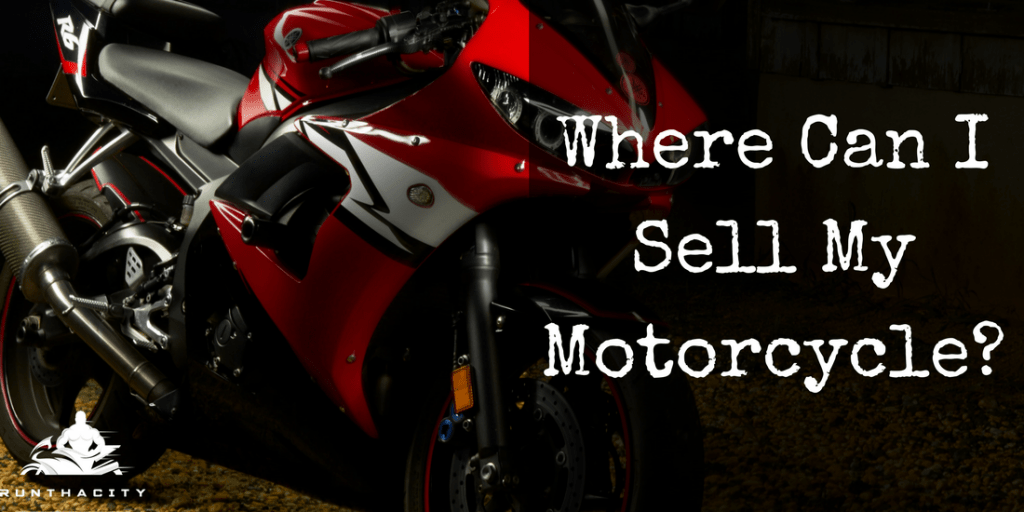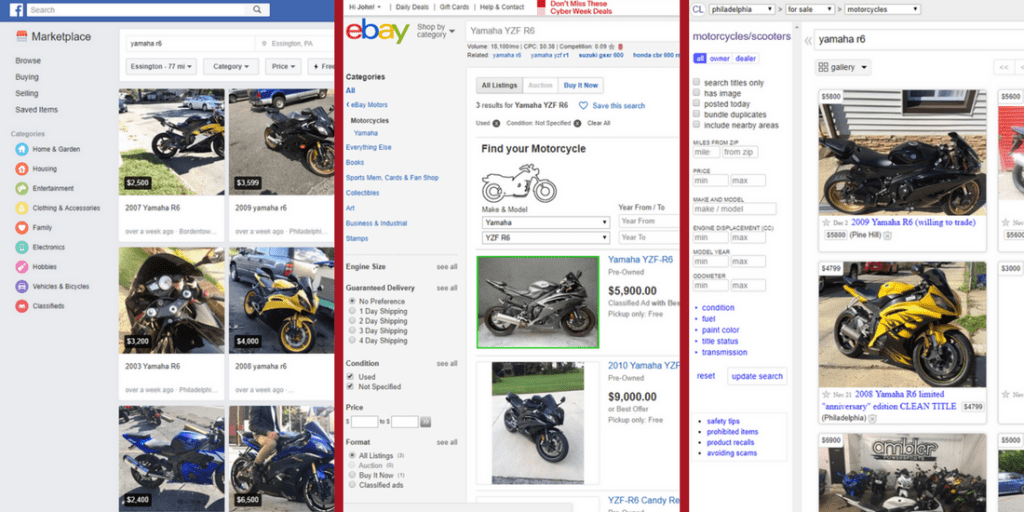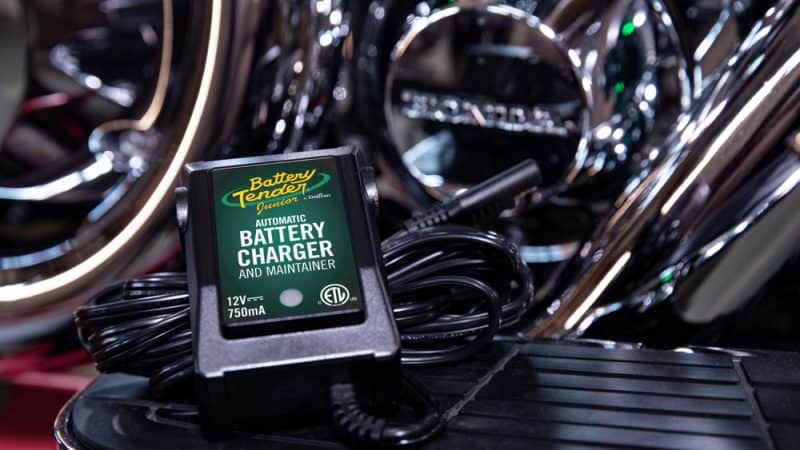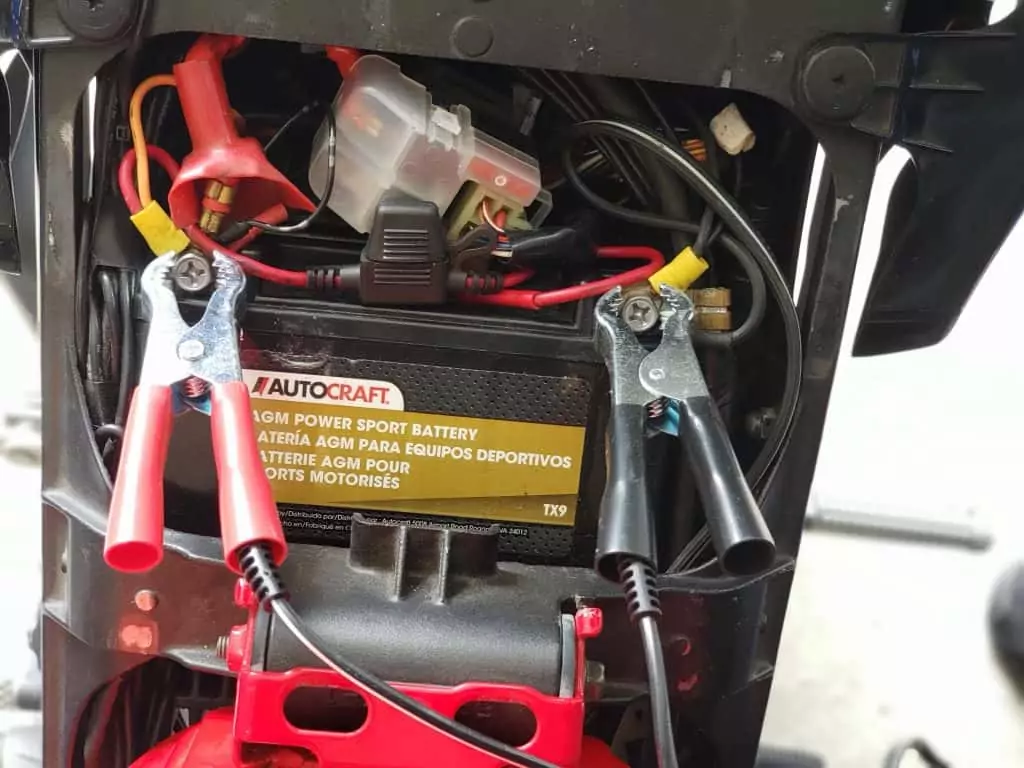If you have made the decision to sell your motorcycle, whether because you want to upgrade or because you have different priorities, knowing where to sell your bike is as important as knowing what to ask for it.
Selling your bike is already a difficult enough decision in many cases, so there is no need for the added stress of knowing the best place to sell your motorcycle. These tips can help you find the perfect place to sell your bike and will provide you with some tips that could make the process go more smoothly. You can find a few more tips on how to sell your motorcycle here.

Where Can I Sell My Motorcycle Offline?
Selling a motorcycle offline may not be as difficult as you think. You can place a “For Sale” sign on the bike when it is parked in your yard and it is possible someone riding by may decide it is the perfect bike for them. You can also take out an ad in the classified section of your local newspaper, although you will need to pay for the ad whether the bike sells or not. If there is a bulletin board in your neighborhood where people post about lost pets or yard sales, ask if you can post a sign about your motorcycle.
Tell your friends, family and co-workers that your bike is for sale. They may know someone who is in the market.
If you are selling your bike because you want to upgrade, talk to the dealer about trading in your old bike on a new one. Keep in mind that a dealer may offer you less for the bike than you could get if you sold it yourself, but it would eliminate the hassle of selling it yourself.
Offline Selling Options:
Dealership: Selling your motorcycle to a dealership can be a convenient option if you’re looking to trade it in for a new model. While you may receive a lower offer compared to selling it privately, it eliminates the hassle of handling the sale yourself.
Local Newspaper: Placing an ad in the classified section of your local newspaper can reach potential buyers in your community. However, you’ll need to pay for the ad, regardless of whether your bike sells or not.
Front Lawn: Putting up a “For Sale” sign on your bike while it’s parked in your yard might catch the eye of passersby, leading to potential buyers.
Flea Market or Motorcycle Show: Participating in flea markets or motorcycle shows can expose your bike to a targeted audience of enthusiasts who might be interested in purchasing it.
Bulletin Boards: Check if there are bulletin boards in your neighborhood where you can post a sign about your motorcycle for sale.
Advantages of Offline Selling:
When you sell your motorcycle offline, one cool thing is that you can reach folks right in your own community. You might get lucky with someone riding by, checking out your “For Sale” sign, and thinking, “Hey, that’s the perfect bike for me!” Plus, you get to have those face-to-face interactions with potential buyers. It’s a chance to show off your bike in person, talk about its features, and make a more personal connection.
Disadvantages of Offline Selling:
Now, the downside of selling offline is that your audience is more limited compared to the vast world of the internet. You’re sticking to your local turf, and not everyone in your community might be interested in buying a motorcycle at that moment. It can take some time and effort to find the right buyer, and you might need to keep at it for a while.
Also, if your motorcycle is kind of niche or unique, you might not find the right audience nearby. It’s like trying to sell an old-school chopper in a town that’s all about sportbikes. You might not find the perfect match for your bike’s awesomeness.
Where Can I Sell My Motorcycle Online?

There are many different online options you can use to sell your bike. Craigslist is a free online advertising service, but keep in mind that some of the people who use the service are not above-board. If a buyer wants to purchase the bike from a Craigslist ad, insist on cash or certified funds at the time of the sale.
Ebay is another option for selling your bike, especially if it is unique or hard-to-find. You do not pay for listing your bike on Ebay until it sells and the buyer will pay for any shipping costs. It could be difficult, however, to find a company that will ship your bike so you want to research shipping prior to listing the bike for sale.
Online Selling Options:
Craigslist: Craigslist is a popular online classifieds platform where you can post your motorcycle ad for free. However, exercise caution as there might be some scammers and fraudsters on the platform. Insist on cash or certified funds for a safe transaction.
eBay: eBay offers a broad audience, making it suitable for unique or hard-to-find motorcycles. You only pay a fee when your bike sells, and the buyer covers shipping costs. Research shipping options before listing your bike.
Facebook Marketplace: Facebook Marketplace has gained popularity for buying and selling motorcycles and parts. With a large user base, it’s an accessible platform to reach potential buyers.
Facebook Groups: Joining motorcycle-specific Facebook groups can connect you with enthusiasts interested in your type of bike.
Motorcycle-Specific Websites: Platforms like Motorcycle.com, CycleTrader, and RumbleOn focus on motorcycles, ensuring your ad reaches a targeted audience.
Facebook Marketplace
Recently Facebook Marketplace has become really popular for buying and selling motorcycles and motorcycle parts. You can discover bikes for sale near you. Easy to use on your phone or your desktop, and most people already have a Facebook account.
Take a look at a few other places you can sell your sportbike online:
The Best Apps to Sell My Motorcycle

One option for selling your bike online, designed specifically for buying or selling motorcycles, is RumbleOn. The site is available as a mobile app that allows you to put in all the info about your bike, take photos and upload to the site. RumbleOn sends you a Cash Offer Voucher that is good for three days. If you agree, they come get the bike and handle all the paperwork.
CycleTrader is another app that allows you to sell motorcycles and also includes reviews available online.
These apps are available in the Apple or Google Play Store:
Google Play Store Apps
On Apple Itunes Apps
Advantages of Online Selling:
Selling your motorcycle online opens up a whole world of possibilities! You get a way bigger audience, reaching potential buyers from different corners of the globe. It’s like your bike is getting the red carpet treatment, and people from all over can admire its beauty.
And the best part? You can do it all from the comfort of your own home, sipping on a cup of coffee. No need to put on pants or leave the house. Just hop online, snap some pics of your awesome bike, and let the internet do its magic. It’s super convenient, accessible 24/7, and you can connect with buyers from anywhere with an internet connection.
The online world gives you cool options for targeted advertising too. If you’ve got a sporty beast, you can hit up those motorcycle-related websites and social media groups where fellow speed enthusiasts hang out. Talk about getting your bike in front of the right crowd!
Disadvantages of Online Selling:
But hey, the internet isn’t all rainbows and unicorns. There are a few things to watch out for when selling online. Scammers and fraudsters like to lurk in the shadows of certain platforms, so you’ve got to be vigilant. Don’t worry though, we’ll tell you how to deal with those bad apples in a bit.
Also, dealing with inquiries and negotiations online can sometimes feel like you’re running a 24/7 customer service hotline. It can take up some of your time, replying to messages and answering questions. But hey, it’s all part of the game, right?
Oh, and shipping logistics, that can be a bit of a headache. Especially if your motorcycle is a big boy. You’ve got to figure out how to get it from point A to point B without a scratch. But don’t worry, where there’s a will, there’s a way! Consider A1Autotransport to transport your vehicle.
Warning about Scams and How to Avoid Them:
Now, let’s talk about those pesky scammers. They’re like the gremlins of the internet, always trying to cause trouble. But don’t worry, we’ve got some tips to keep you safe from their tricks.
First things first, when someone wants to buy your bike, insist on cold, hard cash or certified funds. No personal checks or money orders. Those things can be faker than a unicorn.
If you’re meeting up with a potential buyer, be smart about it. Choose public places with cameras or bring a buddy along for backup. Safety first, always!
And before you hand over your precious motorcycle, make sure any certified funds are legit and safely cleared in your account. No funny business!
Remember, this is about selling your bike, not your life story. Be cautious about sharing personal info with potential buyers. Stick to talking about your motorcycle and its amazing features.
One last thing – do some online sleuthing. Research the buyer’s profile and reputation if you can. It’s like giving them a background check to make sure they’re the real deal.
With these tips in your back pocket, you’ll be a scam-fighting superhero, ready to conquer the online selling world! Stay safe and sell that motorcycle like the boss you are!
Avoid Scams When Purchasing a Mortocycle With This Checklist
Insist on Cash or Certified Funds: Avoid accepting personal checks or money orders, as they can be forged or canceled. Insist on cash or certified funds for a secure transaction.
Meet in Safe Locations: If meeting with a potential buyer, choose public places with surveillance cameras or bring a friend along for added safety.
Verify Payment: Before handing over the motorcycle, ensure that any certified funds are legitimate and have cleared in your account.
Don’t Share Personal Information: Be cautious about sharing personal information with potential buyers. Stick to discussing the motorcycle details.
Research Buyer’s Information: If selling online, research the buyer’s profile and reputation if possible to gauge their credibility.
By following these guidelines, you can reduce the risk of falling victim to scams and ensure a safer selling experience.
In conclusion, selling your motorcycle can be a challenging decision, but with the right approach and platform, you can find the perfect buyer. Offline options offer localized reach and personal interactions, while online platforms provide access to a broader audience. To safeguard against scams, practice caution, and follow best practices when dealing with potential buyers. Good luck with your motorcycle sale!
If you want more information on selling your motorcycle or need tips on getting the best price for your bike, subscribe to our YouTube channel.
You Might also like
-
How To Use A Battery Tender®
One of the most heartbreaking situations any car or motorcycle lover will experience is when you have beautiful riding or driving weather, are excited to hit the road, and the engine doesn’t turnover. The reason? Low battery power.
If you have a nifty gadget called a Battery Tender®, you can recharge the battery and bring it back to life in no time. A Battery Tender® is a friendlier alternative to traditional battery charges because of the technology housed within the device that is designed to prolong battery life.
Before you decide to buy a Battery Tender®/Maintainer, though, let’s talk about what they are, what battery maintainters do, and why you should have a maintenance charger for your motorcycle.
No products found.No products found.
What Is A Battery Tender®?
Also known as “float chargers” or “maintenance chargers,” Battery Tender® were first created by the U.S. company Deltran in 1965. What separates battery tenders from plain ol’ chargers is that these devices provide a constant voltage supply but also are controlled by processors. In other words, they are able to refrain from charging faulty batteries, use spark-free technology, and have green and red indicators that help you understand what’s happening in just a glimpse.
A Battery Tender® is the opposite of a trickle charger, an unsophisticated, less expensive option. Though the purpose is similar, a trickle charger doesn’t have microprocessor technology that prevents it from damaging the battery if you leave it charging for an extended period of time. Furthermore, you can use a battery tender when you plan on storing your motorcycle for several weeks on end, like over winter.
Keep in mind that a Battery Tender® is not able to jump-start a long-dead battery. When this happens, you need a trickle charger.
For this reason, you can think of a Battery Tender® as a trickle charge with a brain—the exact words of the original manufacturer, Deltran. Of course, there is more than one brand of Battery Tender® available on the market.
For example, the DieHard Battery Charger/Maintainer is similar to a Battery Tender that employs things like Float Mode Monitoring to charge more than just motorcycles. Whichever model you choose, just make sure they have features like auto-adjust amperage to help maintain the charge, easy-to-read indicator lights, and float mode monitoring.
No products found.No products found.
Using A Battery Tender®
Operating a Battery Tender® is easy. To use a one of these devices, you just plug it into any standard AC outlet and use it to transfer power to the 12-volt battery in your motorcycle.
When preparing to use the battery tender, keep the AC and DC cords away from the vehicle. Keep the charger off until you have everything plugged in.
Depending on the motorcycle, the connections might differ, so refer to your owner manual. Once you have the battery tender connected to the correct posts on the battery, you can switch it on.
You should see indicator lights turn on, such as:
• Flashing red light – AC power and microprocessor is functioning properly. However, if the flashing continues, the voltage might be too low. Take a look to make sure the alligator clips are attached properly.
• Steady red light – The clamps are properly place and power is being transferred to your battery. The light will remain red until the battery is fully charged.
• Flashing green light – A flashing green light is often paired with a red light. This means the battery is about 80% charged and can be used.
• Steady green light – The charge is complete. You can keep the battery tender attached to the battery to help maintain the life of the battery if it will be sitting for an extended period of time.Quick note: If your battery has less than 3 volts, the battery tender won’t start. The battery should produce at least 3 volts. On the same note, if you have a standard 12 volt battery that is defunct and is producing less than 9 volts, the battery tender won’t work properly.
No products found.
Takeaway
Trickle chargers bring dead batteries back to life while battery tenders prevent batteries from losing power during periods of inactivity. Whether you use your bike every other day or less frequently, a battery tender will preserve the life of the battery to ensure your motorcycle is ready to ride whenever you need to hit the road. The straightforward usage makes it a wonderful investment for every motorcycle enthusiast.
Now that you’ve done you’re reading, it’s time to check out the motorcycle videos on my YouTube channel. Don’t forget to subscribe and receive notifications so you never miss an update!
No products found.
No products found.
-
HJC IS-17 Motorcycle Helmet Review
The HJC IS-17 helmet is one of the most popular in HJC street helmets, made of advanced polycarbonate composite and with a new 3D face shield design. It is kind of a mixture of the HJC FG-17 and the HJC CL-17, although the FG-17 has a fiberglass composite shell and the IS-17 has a different fit than both the CL-17 and FG-17. Although the IS-17 has a comfortable fit and a sun visor that provides excellent coverage, it does not have good ventilation and the internal sun visor means it does not have Snell certification.
HJC IS-17 Motorcycle Helmet Overall Quality
All the parts of the IS-17 move together well despite the fact that the recommended retail price is around $162. Despite the cost, the paint and finish are good quality and comparable to helmets that are similarly priced, although it should not be compared to higher priced helmets like Arai or Shoei. The chin curtain, like the CL-17, is an option, although for a few extra dollars, it could be included as standard. The pinlock insert is also an option, although it is not as critical as the chin curtain. The clear plastic face shield has some waviness and clouding that could result in a visibility problem. In addition to the face shield, the fact that 85 percent of the vent holes are blocked is an issue. Very little air flows through the vents to the rider and the fabric liner across the top blocks the top vent.
Click Here For HJC Helmets 2017 Catalog
Helmet Fit, Internal Shape and Liner
The sizing seems slightly off in the IS-17 with an “XL” fitting more like an “L” and the internal shape feels mostly “neutral” rather than “slightly round” like other HJC helmets. This may be due to the sun visor at the forehead which gives a feeling of less room inside the helmet and a snug fit. The interior is nicely padded and the fabric comfortable. You can remove the cheek pads and liner for washing. There are also optional cheek pads in sizes that range from XS, at 40 mm thickness, to XXL, at 25 mm thickness.
HJC IS-17 Face Shield, Outward Visibility
The face shield operation in the IS-17 is exactly the same as the FG-17 with a center locking lift tab that works fine on the helmet. The center locking lift tab also allows you to adjust for city positions or for an initial defogging. It does have waviness that could affect visibility and which some riders may find unacceptable. The eye ports seem to be slightly better than average despite the sun visor. Once the shield is locked shut, it seals tightly around the eye port gasket. Water drains away from the rider along the top of the gasket and along the sides through a rotating mechanism. The face shield is easy to remove and can be replaced with optional mirrored or tinted face shields.
Helmet Ventilation and Air Flow
Ventilation and air flow in the helmet is one of the biggest problems. The top vent looks as if it should draw in a lot of air but the holes through the lining do not come close to lining up with the vents. In addition, the fabric liner blocks the vent holes to the point that even if air came into the helmet, you would not feel it because the holes are covered. This is not only true of the top vent, but also for the rear exhaust vents. The chin vent does direct air up, but it is an option with a price of between $4 and $5, something that is worth the added cost.
How are the Helmet Sound Levels?
The HJC IS-17 is quieter than most helmets with general wind noise around the sides. However, since the fit is tighter than other HJC helmets, it keeps the noise levels low. It works well as a windscreen and has low turbulence noise as well. Because the top vent holes are blocked, there is very little noise from the top of the helmet.
Although most of the features of the IS-17 make it a good option, the fact that it does not have the Snell M2010 rating is a major drawback. Studies have shown that nearly 23 percent of helmet impacts are in the forehead region where the internal sun visor sits. In addition, the top vent system and the wavy face plate present significant problems.
-
The Best Stretching Exercises for Sportbike Riders
Riding a sportbike can be an exhilarating experience, offering a sense of freedom and excitement. However, it can also be demanding on the body, particularly on the muscles and joints used most during rides. To ensure both safety and enjoyment while riding, incorporating stretching exercises into your routine is essential. Below, we outline the best stretching exercises specifically designed for sportbike riders, aiming to enhance flexibility, reduce muscle stiffness, and prevent injury.
Key Takeaways
- Stretching improves flexibility and range of motion, essential for comfortable and safe riding.
- Regular stretching can prevent muscle stiffness and soreness, particularly in areas heavily used during rides such as the wrists, shoulders, and legs.
- Incorporating exercise stretch bands can enhance stretching routines, offering resistance that can help improve overall flexibility.
Comparison Table: Stretching vs. No Stretching for Sportbike Riders
Criteria With Stretching Without Stretching Flexibility Improved Decreased Muscle Soreness Reduced Increased Injury Risk Lowered Elevated Riding Comfort Enhanced Compromised Recovery Time Shortened Lengthened Why Stretching is Crucial for Motorcycle Riders
Before delving into the specific exercises, it’s important to understand why stretching is so beneficial for motorcycle riders. Stretching can improve range of motion, decrease the risk of muscle soreness and injuries, and enhance your overall riding experience by keeping the body flexible and prepared for the demands of riding.
Best Stretches for Motorcycle Riding
- Wrist Extensor and Flexor Stretches
- Purpose: Alleviates wrist stiffness and prevents arm pump.
- How to Do: Extend your arm, palm down, and gently pull the fingers towards your body with the other hand. For the flexor stretch, extend your arm, palm up, and pull the fingers towards your body.
- Shoulder and Chest Openers
- Purpose: Opens the chest and shoulders, counteracting the forward-leaning posture.
- How to Do: Interlace your fingers behind your back, straighten your arms, and lift your chest upwards, feeling the stretch in your shoulders and chest.
- Hip Flexor Lunges
- Purpose: Loosens the hip flexors, crucial for maintaining a comfortable riding position.
- How to Do: Step forward into a lunge, keeping the back leg straight and the front leg at a 90-degree angle. Push your hips forward.
- Quadriceps Stretch
- Purpose: Stretches the front thigh muscles, which can become tight from the riding position.
- How to Do: Standing on one leg, pull the other foot towards your buttock, keeping the knees together.
- Seated Hamstring Stretch
- Purpose: Increases flexibility in the back of the legs.
- How to Do: Sit on the ground, extend your legs, and reach towards your toes.
- Glute and Piriformis Stretch
- Purpose: Relieves tightness in the buttocks and lower back.
- How to Do: Sitting on the floor, cross one leg over the other and gently pull the knee towards the opposite shoulder.
Incorporating Stretch Bands for Enhanced Flexibility
Exercise stretch bands can be a valuable tool for motorcycle riders looking to enhance their stretching routine. They provide resistance, increase the effectiveness of stretches, and help improve overall flexibility. Here are a couple of stretches using exercise bands:
- Band-Assisted Hamstring Stretch: Lie on your back, loop a band around your foot, and gently pull back, keeping the leg straight.
- Shoulder Stretch with Band: Hold a stretch band in both hands, lift your arms over your head and behind your back, stretching the shoulders.
FAQs on Stretching for Motorcycle Riding
- How often should I stretch?
- Ideally, before and after each ride to warm up and cool down the muscles.
- Can stretching improve my riding performance?
- Yes, by enhancing flexibility and reducing muscle fatigue.
- Are there stretches to prevent lower back pain from riding?
- Yes, hip flexor stretches and lower back stretches can help alleviate and prevent lower back pain.
- Why is stretching important for motorcycle riders? S
- tretching improves flexibility and reduces the risk of muscle stiffness and injuries, making riding more comfortable and enjoyable.
- How often should I stretch for the best results?
- Ideally, before and after each ride to prepare your muscles for the ride and to aid in recovery afterwards.
- Can stretching help with lower back pain from riding?
- Yes, specific stretches targeting the lower back and hip flexors can alleviate and prevent lower back pain.
- Are exercise stretch bands beneficial for riders?
- Yes, they add resistance to stretches, effectively improving flexibility and strength in key muscle groups.
- What are the best stretches for sportbike riders?
- Wrist, shoulder, hip flexor, quadriceps, hamstring, and glute stretches are highly beneficial.
- How long should each stretch be held?
- Each stretch should be held for at least 30 seconds to maximize its effectiveness.
Conclusion
Incorporating these stretching exercises into your routine can significantly enhance your motorcycle riding experience. Not only do they prepare your body for the ride, but they also help prevent post-ride stiffness and soreness. Remember, consistency is key to seeing improvements in flexibility and to enjoy a more comfortable and enjoyable ride.
For more tips on fitness and motorcycle riding, check out our Fitness Blog at RunTheCity. Whether you’re a seasoned rider or just starting, understanding and practicing these stretches can lead to a healthier, more enjoyable riding experience.






 HJC IS-17 Face Shield, Outward Visibility
HJC IS-17 Face Shield, Outward Visibility How are the Helmet Sound Levels?
How are the Helmet Sound Levels?




As a cashed up buyer I have been going through the adds looking for a motor bike. I find it very off putting to a point I won’t even consider the bike when sellers write things like no time wasters, no tire kickers, no test ride jockeys etc. If I turn up and don’t like the bike or consider it not the bike for me I wonder what their reaction will be. They may have the bike I would buy but with their attitude they display in their add I would never consider it.
After coming across this article I wanted to bring your attention to another option for selling a motorcycle online. The website Cash4Motorcycles.com offers free price quotes and they make selling easy. After getting a free online quote a seller can contact Cash 4 Motorcycles to schedule an appointment to have them come to the sellers location and purchase the motorcycle on the spot. There is no need for sellers to mail their title off and wait several days to have funds wired to their bank account. Once Cash 4 Motorcycles driver arrives at the sellers location they inspect the motorcycle, takes care of the paperwork and load up the motorcycle immediately. There is no need to make a separate appointment with a shipper to pick up the bike. The Cash 4 Motorcycles slogan says it all “We Make Selling Easy!”
Hi. I have a custom built 2014 HD sportster 1200xl with less than 6000 miles on it.
Roland Sands accessories, screaming eagle motor upended, carbon fiber pipe,tricked out!
It’s like a drag bike/racing bike all in one. Very,very fast!! I’m asking $9500.00, but I am willing to negotiate.
Urgent selling my Royal Enfield classic 350 cc my contact number is my WhatsApp number 9101864439
https://dailybikers.com/